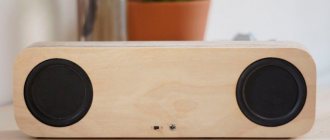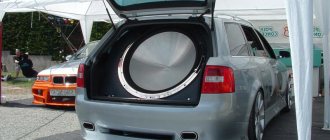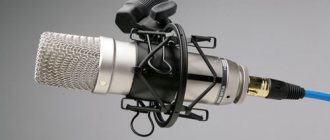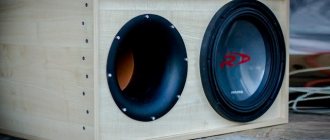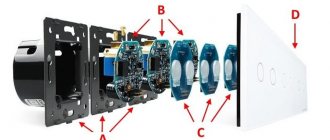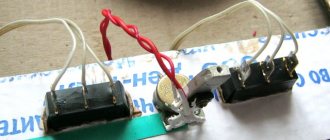Speakers are an acoustic system and come in a variety of sizes. From a huge music center to a portable small battery-powered speaker. This device is quite simple and can be assembled at home.
Acoustic system design
Typically, speakers consist of several speakers, which in turn consist of several magnets (usually two). The operation of the magnets is controlled by an amplifier that operates at audio frequencies.
Speakers are divided into two types: passive and active. In passive devices, the amplification element does not require additional power. The simplest passive system is regular headphones. Active devices require additional power to function.
Speaker technical data
- System: 2-1 with 2-way low-frequency reflector
- Rated power continuous – 600 W RMS
- Peak power – 1200 W
- Efficiency (1 W at 1 m) – 102 dB
- Maximum SPL – 129 dB
- Frequency response (-3 dB) 62 Hz – 20 kHz
- Nominal resistance – 4 Ohms
- BR setting - 55 Hz (measurement)
- Material – 12mm hardwood plywood
- Finish – structural varnish
- Speaker weight: 27 kg
- External dimensions (HxWxD) – 102 x 40 x 43 cm
- BR tunnels – two PVC pipes with a diameter of 110 mm and a length of 70 mm.
- The usable volume of the speaker is 97 liters.
- Woofers – 2 Celestion TF 1225 tweeters
- Tweeter – STX D800ti MRH-83
- Bandwidth – 18/12 dB passive crossover with switching stabilizer.
The body was designed using 3D technology, which allows you to predict all the complex physical relationships of elements with each other, in other words, you can almost feel the finished project while it does not yet exist, plan every little detail and there will be no mistakes that something will not fit . Even at the design stage, you can achieve the highest accuracy.
DIY computer speakers
In order to assemble a PC speaker system you will need:
- Speaker 3W (from 2 pcs.).
- Mini-Jack 3.5mm connector (it is standard for connecting speakers or headphones and is very common).
- Audio amplifier. It is recommended to use digital RAM 8403.
REFERENCE. Instead of a digital amplifier, you can use an analog amplifier with transistors, but then you will have to use a DAC, and selecting the necessary digital-to-analog converter is a rather lengthy thing that requires special calculations. At its core, the RAM 8403 is an amplifier with an ADC, which makes it easier to assemble homemade speakers.
- Toggle switch for powering the system.
- Connecting wires.
- USB cable for power.
- Heat-shrinkable tubes for insulation.
- USB plug.
- Material for assembling the case (plywood, glue, screws, etc.).
You will also need tools:
- Soldering iron.
- Glue (for gluing wires).
- Knife (for cleaning wires).
- Jigsaw (for working with the body).
- Drill (for working with the body).
- Tools for measuring and marking (pencil, ruler, compass, etc.).
- Cutters (for wires).
- Sandpaper (for processing the body).
Making a “bun”
In order to ensure the highest quality sound, it is necessary to make a spacious and closed enclosure so that air circulates in it. This will make the sound deeper and richer.
We make the case
Chipboard, fiberboard or plywood will be used for the body. You can also use textolite or OSB. You should not choose plates that are too thick, as this will make the structure too heavy.
In order for the speakers to fit, you need to correctly measure the diameter and circumference, and then cut the holes on the front panel.
ATTENTION. You should pay attention to fixation, since the speaker housing is often subject to vibration. In addition to glue, it is better to use corners with self-tapping screws. This way the design will be more reliable and will last longer, and it will also be possible to disassemble the device and then reassemble it.
On the rear panel there should be places for the power cable, connection cable and a separate connector for the power switch.
Let's take care of a good power supply
There are several basic options for creating a power supply in a circuit. If the amplifier is a complex device with an ADC and an adapter (such as RAM 8403), then it can be powered from a simple USB. This makes it easier to interact and work with your PC. If there is a separate power supply, then you should carefully select components according to consumption and output power.
ATTENTION. All wires and cables must be chosen at the optimal length, since wires that are too long can get in the way and cause inconvenience. In this case, the cables should easily reach all the necessary connectors. The optimal length of mini Jack and USB wires ranges from 1 to 5 meters.
Amplifier and power supply
To assemble a home audio system, you need to connect the loudspeakers (speakers) with an amplifier and a connector. The mini-Jack plug has three channels (left, right and common). They are separated by black stripes on the connector itself and are located mirrored from the middle.
On the board itself there are connectors for the wire (L-Left G-Central R-Right). Observing the order, you should connect the mini-Jack connector with the wires to the amplifier board.
Then, observing the polarity, you should connect the speakers to the amplifier. The speaker locations on the device are designated as Rout and Lout.
IMPORTANT. When connecting speakers, remember the polarity
This device will be powered via USB, since 5 volts is sufficient for the amplifier. When soldering the power cable, you should also remember the polarity. It is also important not to forget to connect the toggle switch from the speaker power supply through one of the wires, otherwise the device will be powered every time it is connected via USB.
After all the parts are assembled, you should use heat shrink in the bends, namely on the mini Jack, the power switch and the wires that connect to the speakers.
Main columns
After the main device is assembled, it should be placed in the previously assembled housing. Assemble the speakers carefully, as there is a risk of damaging the wires or connector.
ATTENTION. The RAM 8403 has a gain control knob. It should be displayed on the front or side panel of the device.
Sometimes, to improve sound quality, the front panel (where the speakers go) is covered with fabric.
Subscribe to our Social networks
Finished my monsters (01-12-2008)
Here's what happened... I covered the speakers with self-adhesive ebony.
In terms of pasting with self-adhesive, this is my first experience. But they look quite... The most tedious thing in preparing for gluing is leveling the surfaces. I used acrylic universal putty, sandpaper, recordings of my favorite bands, a little patience and quite a bit of beer... I was pleased with the result!
Specification from the manufacturer:
- Impedance: 6 ohms
- Power: 30W
- Diameter: 52 mm
- Height: 23 mm
- Diagonal distance between mounting holes: 45mm
- Front panel thickness: 3mm
General form:
Flange outer diameter - 52 mmThe diameter of the tweeter housing holder is 36 mm
Resistance - 5.6 Ohm, (probe resistance - 0.2 Ohm)
From the front side it looks very neat, from the inside there are sagging plastic. There is nothing more to review, you need to install them and try them.
↑ Refinement of speakers
Unfortunately, over time, the parameters of the speakers deteriorate, first of all this concerns the woofers due to the fact that their diffuser has the largest vibration amplitude.
The rubber suspension becomes dull and the current-collecting wires are destroyed. If necessary, to restore quality, you need to repair the speakers, paying special attention to the suspension. I proposed a modification option in the article “Refinement of small-sized speakers 15AC-109 and the like.”
The midrange speakers also need to be improved. Soak the corrugation (the entire diffuser cannot be soaked) with a liquid solution of guerlain. The process is described in detail by Shorov and his followers. But this was not enough. When listening to the assembled and configured speakers, the sound was somewhat harsh. The reason turned out to be the high acoustic quality factor of the speakers. I had to use PAS, which gave a noticeable positive result.
Attempts to modify the 2GD-36 using the method of improving the 3GD-31 did not give a positive result.
↑ Results
Thanks to the complex of measures outlined above, a good result was obtained, above expectations.
The sound is not great, because... it requires higher end speakers, but good ones. I think it’s better than any Soviet small-sized speaker, which is not surprising because they are two-way. As for industrial three-lanes, the situation here is ambiguous. It is clear that in terms of power (volume level), my speakers cannot compete with the 25AC and 35AC series of clones. They cannot compete in terms of the amount of bass, despite the fact that my speakers operate from approximately 34 Hz at a level of -3 dB, a speaker with such a small diameter is noticeably inferior in power to the woofers of the 25GD, 30GD series.
But 2GD-36 sounds softer than 10GD-35. And the main advantage is in the midrange. Rubber 15GD-11 sound clearly worse, although louder. I think the overall balance is in favor of these MACs, but not for lovers of killer bass.
For home use, the volume of these speakers is quite sufficient, despite the low sensitivity of the 25GDN3-4. But for a disco - no. But quality is not needed for a disco.
The purpose of my experiments was to try out some techniques and tuning methods, see what can be done from cheap and affordable speakers, and if the result is positive, offer Datagor readers a new article.
I think that the design is suitable for repetition, the cost of components is low. If I used rare imported speakers, the possibility of exact repetition would be minimal. The frequency range of the speakers is at least 40...20000 Hz, in fact, according to the standard method, even wider.
The speakers work well with V. Mosyagin’s amplifier (MVV) on LM1875 using a “pump” circuit. I don’t give measurement graphs; anyone who wants can measure it themselves, for example, using the methods I described on Datagor.
Thank you for your attention!
Briefly about the acoustics design
The first devices for extracting sound were simple: gramophone records were listened to through bells or mica membranes. The quality of this sound can be heard in old films: against the background of high frequencies, noise, crackling and the rustle of a needle. The next stage in the development of sound transmission equipment was the appearance of the speaker (an electrodynamic emitter with a conical diffuser) - it was invented in 1924.
The first devices were large in size and had a limited frequency range. But for those times it was know-how. Over time, speakers have been upgraded and manufactured using modern technology. Their frequency range was assessed as broadband, and later multiband ones appeared.
To produce high-quality acoustics, it includes not only speakers that better transmit high frequencies, but also massive subwoofers for low frequencies. The minimum number of emitters in a normal column is 2 pcs. Higher class acoustic music system contains up to 6 pcs. and 1 subwoofer. Modern speakers operating in mono sound mode are practically not produced. The exception is acoustics for military and federal purposes.
“Mono” was replaced by:
- "Stereo". This mode is provided by two channels that contain the entire frequency spectrum.
- "Sound around." The speakers have a larger number of channels (4 and above), which create a surround sound effect.
How to calculate the dimensions of plywood to create a body?
- To determine the size of the case, you need to focus on the dimensions of the speaker, as well as the free space where you plan to install the system. The documentation that should come with the speakers will help you navigate the parameters. If it is not there, then you can take the measurements yourself, just do not forget to measure the depth, and also leave room to carefully lay all the wires.
- Now you can start making a detailed drawing. Check your calculations carefully so you don't have to do the work all over again. Once you are confident that your actions are correct, you can begin transferring the drawing onto a plywood sheet. Apply all the markings and outline the final result with a red pencil or felt-tip pen, as it is easy to make a mistake in this work.
- Having completed all the preparatory steps, you can begin manufacturing parts and assembling the body. For this task you will need glue, caulk, small nails, a hammer, a hacksaw or sandpaper and an electric jigsaw. First you need to carefully cut out the wooden blanks using a jigsaw. Be sure to carefully sand all edges to ensure there are no burrs, rough spots, or other defects.
- Having prepared all the details, carry out a preliminary fitting. They should fit snugly against each other, without forming distortions or gaps.
- The next stage is assembly. Self-tapping screws or nails can be used to connect parts. If you choose the latter option, then you will have to work carefully so as not to damage the material. Do not forget to coat the joints with glue and sealant, giving them time to dry. This way, sound waves will propagate only within the body, and you, in turn, will be able to enjoy high-quality sound.
- The body is almost ready. Now all that remains is to work on its appearance. The simplest option is to coat the surface of the box with varnish to protect it from environmental influences. But here you can give free rein to your imagination, use leather or other materials to cover the speaker system. The finishing touch is to install the speaker in its designated place and fill the free space with synthetic down.

